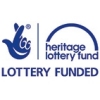Glasgow's War Light Show
A spectacular light show with film, images and audio telling the stories of Glaswegians during the First World War was projected onto Glasgow City Chambers on Tuesday 11 November.
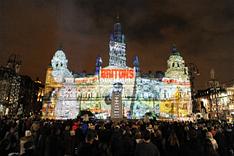
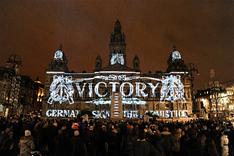
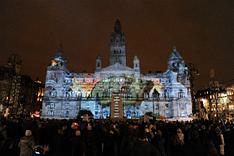
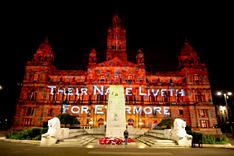
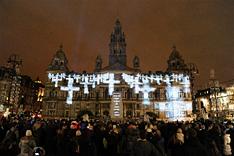
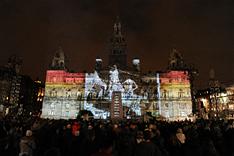 The Glasgow City Council event called 'Glasgow's War' weaved narrative, images film and audio to depict the extraordinary impact of war on ordinary people.
The Glasgow City Council event called 'Glasgow's War' weaved narrative, images film and audio to depict the extraordinary impact of war on ordinary people.
Evoking Glasgow's home front during the First World War, it also related the experiences of soldiers, doctors and nurses on the front line.
Elements of Glasgow's very strong anti-war and peace movement including the role of campaigner James Maxton were also explored.
The stories are bound together in a 27 minute long narrative and have been researched and collated with the help of Glasgow City Council archivists and museum curators from Glasgow and the west of Scotland.
They revealed surprising and little known facts about the war and the people of Glasgow.
For example the United Kingdom Tank Bank was a highly successful fundraising campaign that realised more than £40 million for the war effort. More than a third of that money was raised in Glasgow in response to the horrific stories of war that were emerging from the front line and the merits of this recently introduced weapon.
The show has been put together by projection artists Ross Ashton and sound artist Karen Monid who collaborated on the highly acclaimed Golden Jubilee light and sound show that was beamed onto Buckingham Palace in 2002.
They also won plaudits for their work 'Iconic Spectaculars', detailing Britain's Sporting highlights which was screened on the Houses of Parliament during the London 2012 Olympics Paralympics.
It's a return trip to Glasgow for Ross and Karen who created a similar and highly successful projection show for Glasgow City Chambers - 'Burns Illuminated' - to mark the 250th anniversary of the birth of Robert Burns.
There were seven screenings of Glasgow's War on Armistice Day night at 7pm, 7.45pm, 8.30pm, 9.15pm, 10pm, 10.45pm and 11.27pm.
Simultaneously, a second light show beamed the names of every Glaswegian who fell during the conflict on to the Cenotaph.
Glasgow's Lord Provost Sadie Docherty, who is championing the city's four year centenary commemorations for the First World War, said she hoped the event would inspire today's Glaswegians to connect with their city's war past.
The Lord Provost said: "This is not a dim and distant history for Glasgow. One hundred years on, we are all connected to the First World War, either through our own family history, the heritage of our local communities or because of its long term impact on society and the world we live in today.
"The war changed Glasgow and Glaswegians forever. More than 200,000 men went to war from our city, 18,000 never returned and a further 35,000 were left badly injured or disabled.
"The war also totally transformed the role of women in society when they stepped into the jobs vacated by men going off to war. We need to ensure that these stories of Glaswegians between 1914 and 1918 are captured and saved for future generations and I hope that the spectacular Glasgow's War installation will inspire people to learn about their own family histories."
Ross Ashton, who holds two Guinness World Records for his work, said: "It's a great honour to be asked back to Glasgow for such a moving and important event in the city's history. Like many people we were unaware of the deep impact of World War One on the city of Glasgow and it has been a moving and humbling experience."
Karen Monid said: "We wanted to make this piece a personal journey for Glasgow. The voices you will hear are almost entirely the voices of Glaswegians from words written at the time. Drawn from documents of the period - this is the city of Glasgow telling its own story."
The entire frontage of the Glasgow City Chambers acted as a massive screen on the 11 November and 24 high power projectors were use to project the hundreds of images onto the building.
The event also featured text taken from letters, diaries, newspaper and speeches from 1914-1918. Some texts have been specially transcribed for the event and have never been heard before. They include a first hand account of a soldier's life in the Mesopotamian campaign of 1917 and the prison letter of anti-war campaigner James Maxton.
The audio pieces were read by a number of Glaswegians ranging in age from 16 to 60-years-old. They included students from Bellahouston Academy and the University of Glasgow and Glasgow Museums staff. Bellahouston lost 152 former pupils and staff while Glasgow University lost 761.
It also includes readings from the families of First World War heroes including Jennifer McInnes, the great granddaughter of Victoria Cross recipient Henry May and Richie McColm, the great grandson of Distinguished Conduct Medal recipient Piper Kenneth McLennan.
As well as the main projection onto the City Chambers, the artists have also created another installation which was projected onto the Cenotaph featuring the names of the nearly 18,000 Glaswegians who died in the war. This screening is expected to last four and a half hours as each of the names is scrolled onto the Cenotaph.
Earlier this year, Glasgow launched its www.firstworldwarglasgow.co.uk website which called for stories from Glaswegians from the front line and home front to form part of a permanent online tribute to those involved in the Great War in Glasgow..
The website was designed and produced in-house by Glasgow City Council. It grew out of a Development & Regeneration Services' heritage project called Their Name Liveth For Evermore - Glasgow 1914-2014.
The 'Their Name Liveth For Evermore' project received money from the Heritage Lottery Fund as part of an educational programme to allow school children to learn about the names behind the war memorials in their local areas.
The First World War website features a HLF-funded database of stories, memorials and cemeteries housing war memorials and veterans.
The Heritage Lottery Fund money forms part of the First World War Centenary programme to enable communities to conserve and share their heritage and develop projects that improve understanding of the conflict.
The First World War was a turning point in world history. It claimed the lives of more than 16 million people across the globe and had a profound impact on the world.
The projection and sound installation is part of a programme of activities and events to raise awareness of the role Glaswegians play during the war both at home and on the front line.
The www.firstworldwarglasgow.co.uk database will collect stories submitted of Glaswegians during the First World War. These stories will be archived when the site closes to new stories on 11 November 2018 (the 100th anniversary of the end of the war).
More photographs from the night can be viewed here.
To discover more about the Tank Banks, visit RBS Remembers.
Visit The Projection Studio for more information on Ross Ashton, and to find out more about Karen Monid visit her website.












